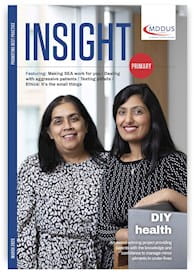
SIGNIFICANT event analysis (SEA) is now (hopefully) embedded as an ongoing process which supports complaints handling and acts as a collective learning exercise within general practice. But when was the last time that you took stock of how much value your practice is getting out of the process?
Many of the SEAs we see at MDDUS in our role assisting members with potential medicolegal cases are more of a description than analysis. A lack of analytical rigour in SEAs, if routine, can lead to poor engagement in the process with much less learning and a reduced impact on patient safety. If your practice is sleepwalking through SEAs, consideration of the following can help.
How are events targeted for analysis?
Factors at play here include the use and effectiveness of your incident reporting processes. Does the team understand what to report? Are low level incidents, near misses and ‘good catches’ being collected, as well as significant incidents for thematic review? There is some evidence that unless there is a significant proportion of these incidents reported, it may be that your processes are not sensitive enough.
Among additional benefits in capturing lower level but repetitive incidents is the identification of training needs and also a reduction in unnecessary follow-up activities. Practices should also consider who reports incidents. Are the same people putting forward the same events for discussion or do SEAs cover the full range of services/activities undertaken by the practice? Does your organisational culture support self-nomination? Staff who feel unsupported are unlikely to report an incident in which they were involved.
It can be helpful to nominate a member of the team to review all reported incidents on a regular basis in order to identify themes. Particular systems or protocols associated with lower-level incidents can then be targeted for analysis, and solutions presented for a sense-check at team meetings. Highlighting efficiencies and safer protocols adopted as a result of such reporting can encourage future engagement. Reviewing the ease of reporting is also important: achieving a balance between simplicity and gathering appropriate data is crucial.
Who do you include in the process?
Some clinical incidents may be too sensitive for discussion in a wider team setting, but should an SEA involve non-clinical systems it is essential that a suitable member of the admin team is involved to ensure that any changes are sensible and do not create additional risks. Alternatively, clinical SEAs or admin-only SEA outcomes can be briefed to the wider team at regular practice meetings. Either way it is important to ensure changes are properly understood (and embraced) by the wider team.
Routine SEA meetings involving the full team should include a range of topics or potential risks (errors) over a set period of time (e.g. a year cycle). This will ensure that no one group feels alienated or unengaged in the process.
How is the SEA meeting structured?
Many practices use similar styled templates for structuring conversation and analysis around significant events. A structured approach is essential but it can often end up being used as a ‘documentation’ tool rather than an in-depth ‘learning’ tool. A highly structured conversation in the context of a busy agenda may disincentivise discussion after “high-level factors” are identified. Staff may be reluctant to address other contributing factors and may feel pressure to “move onto the next agenda item” or “wrap the conversation up”. There may be a reluctance to express any implied (or implicit) criticism of others, or to draw others into the mix by expanding the depth or breadth of the analysis. A good chair should be able to manage the time spent on each agenda item, whilst ensuring that enough exploratory questions are asked in each area of analysis.
It’s useful to collect as much information as possible beforehand in relation to the event(s) in question, in order to maximise the quality of discussion. This could include more detailed written statements, copies of current policies or other records, as appropriate.
Is the most comprehensive learning extracted?
Often only superficial learning and training opportunities are identified through the SEA process. What went wrong may be put down simply to: “the process or protocol wasn’t followed” or “the person should have asked for advice from a colleague at the time of the incident”. Subsequent learning is then noted as: “the protocol should be followed in these circumstances” or “in future a GP should be asked to speak to the patient if they present in this way”. Such conclusions may be true but unless “why” questions are asked, many incidents are more likely to reoccur.
This is because in most scenarios there will be other underlying factors that contributed to the adverse incident. Such factors usually range across:
- People – the specifics of the patient or the team member involved.
- Activities – the task(s) or process that the individual (or team) were engaged in at the time.
- Environment – the setting or situation within which the incident occurred.
Asking “why” multiple times will help draw each strand of an investigation to its natural start point. Indeed there is evidence that asking “why” five times is the optimal strategy to achieve deeper learning and a root cause.
Exploring the contributory factors more fully should lead to findings such as: “the protocol was not followed because the individual was under too much pressure” or “the GP was not consulted for advice because the receptionist was too scared to approach them”. In the latter example, asking why is likely to identify whether the receptionist needs support to be more assertive, or whether the GP needs to adjust their manner or response to interruptions.
Identifying such underlying issues can often be uncomfortable and challenging to resolve. They may relate to deficiencies within practice management/leadership or ingrained behaviours created by stress/overload – but such causal factors will likely lead to future incidents if not recognised and resolved.
Are outcomes being maximised?
To ensure that any lessons learned from incidents are cascaded properly, the practice should agree a mechanism by which staff not directly involved in an SEA still receive an update. Any amendments to protocols or practice systems should include clear information about the efficiency, effectiveness or patient safety gain from the proposed change, as this is likely to encourage compliance.
Sometimes, research or audit is required to assess the extent of any issues identified, or further training will be necessary to support improved practice. It is important to agree a timescale for completion, and an individual should be appointed to make sure it happens and is reported back.
At the end of the review, an anonymised written record of the analysis, including insights gained, lessons learned and actions agreed should be completed and retained securely. It is often useful to share an SEA with the patient as part of a complaint response to show evidence of quality improvement (e.g. as part of a CQC inspection under KLOE2). Where an event led or could have led to patient harm, an SEA can be used by GPs as evidence of reflective practice for the purposes of appraisal or revalidation.
Should you need assistance in reviewing your incident reporting system, members can access (login required) our Incident reporting checklist on the checklists page in the Training & CPD section on the MDDUS website. MDDUS advisers are also available to review anonymised SEA draft reports, once the investigation has been completed.
Getting this right will set your efforts off in the right direction.
Liz Price is senior risk adviser at MDDUS
This page was correct at the time of publication. Any guidance is intended as general guidance for members only. If you are a member and need specific advice relating to your own circumstances, please contact one of our advisers.
Read more from this issue of Insight Primary

Save this article
Save this article to a list of favourite articles which members can access in their account.
Save to library

